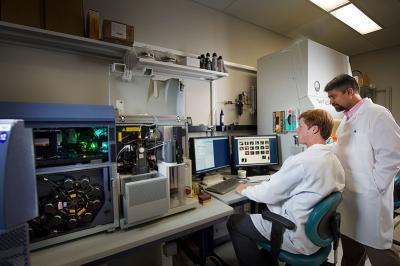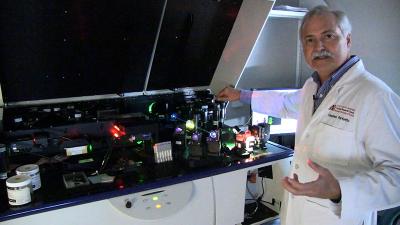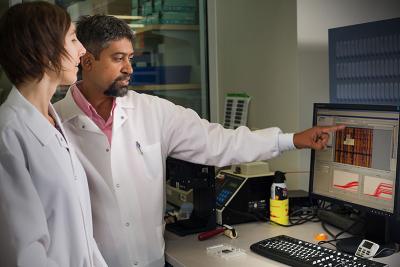Going With the Flow
Pratip Chattopadhyay develops cutting-edge tools to peer into the immune system.

Graduate student Hugh Welles (left) and Pratip Chattopadhyay, Ph.D., discuss characteristics of sorted immune cells
In 1984, scientists discovered the Human Immunodeficiency Virus (HIV), cause of Acquired Immunodeficiency Syndrome (AIDS). As research groups around the world continue the long and costly struggle to produce an effective vaccine, Pratip Chattopadhyay, Ph.D., wants to know how immune cells are responding.
When a viral particle first challenges the body, the immune system identifies these invaders as foreign and prepares to destroy them. Effective vaccines similarly stimulate immune cells, mobilizing hundreds of proteins important for the fight and turning off those that are not needed.

Research fellow Diane Bolton, Ph.D., purifies dyes used to tag proteins on the surface of cells
“If we can find early predictors of an effective immune response, we might be able to speed up vaccine development,” Chattopadhyay explains. “In order to do this, we need technologies that allow us to monitor the immune system before, during, and after vaccination and in natural disease.”

Stephen Perfetto, Ph.D., director of the Flow Cytometry Core at the Vaccine Research Center, explains the use of fluorescent probes to characterize cells
Flow cytometry is Chattopadhyay’s technology of choice for watching the battle unfold. He beams a broad smile whenever he describes progress his group, led by Mario Roederer, Ph.D., has made in measuring the complex combinations of proteins found on immune cells.
The cutting-edge of this technology, polychromatic flow cytometry, was perfected at the NIAID Vaccine Research Center, allowing researchers to simultaneously measure 18 different proteins on a cell by tagging them with colorful fluorescent probes. Chattopadhyay and his colleagues have become worldwide leaders in this emerging technology, actively collaborating with physicians and scientists who have carefully collected clinical data and samples from people suffering from HIV and AIDS.

Different colored lasers stimulate dyes that fluoresce at various wavelengths of light
“If you think about HIV today, most infected individuals in the United States are taking antiviral medication of one type or another,” Chattopadhyay says. “To better understand the natural response to HIV, we had to find samples taken before treatments were available. We had to find the rare samples from decades ago that were still around and study them in the most detailed ways possible using the best technology.”

Chattopadhyay’s team uses an integrated fluidics chip that can simultaneously detect expression of 96 genes within 96 different immune cells
Through collaborations around the country, immune cells in HIV+ samples have been analyzed by polychromatic flow cytometry. Chattopadhyay’s team looked for markers appearing soon after infection that could predict how quickly HIV infection progressed to AIDS. They found simple sets of proteins that are more powerful indicators of progression than standard clinical tests, as well as cells described by more complex protein sets, which shed light on the disease process and potentially the cell types an effective vaccine would need to mobilize.
Identifying 18 different proteins on a cell surface at once is no small feat, but Chattopadhyay still wanted a better look at the immune response. So he and Maria Dominguez, an intramural research training award (IRTA) grantee, developed an immune cell-specific tool that measures expression of 96 genes simultaneously from a single cell. In just a few years, it has become a technology that many researchers use.

Drs. Bolton (left) and Chattopadhyay discuss results from a gene expression experiment using 96 cell samples
Chattopadhyay and colleagues recently used the technology to study the lone modestly successful HIV vaccine candidate developed to date. With samples from trial participants, they purified immune cells induced by the vaccine and examined gene expression. They found a suite of 35 genes that identified five types of immune cells actively responding to the vaccine.

Drs. Chattopadhyay and Bolton in the lab, working on the next breakthrough in understanding immune function
“We probably could have found some of these with flow cytometry, but others were completely new to us and would never have been found using conventional tools,” Chattopadhyay says. “It’s gratifying to see how new technologies can confirm things we already know, but it’s really exciting to watch these technologies teach us new things about immunity.”
So, what’s next?
“There’s always more to do. We develop technologies to study the immune response, apply those technologies in a clinical setting, and then take the knowledge from those clinical studies to help us improve the technology,” he says. “So, the next step? Make it better!”
Pratip Chattopadhyay, Ph.D., is a Staff Scientist in the laboratory of Mario Roederer, Ph.D., in the ImmunoTechnology Section of the Vaccine Research Center (VRC), part of the National Institute of Allergy and Infectious Diseases (NIAID).
This page was last updated on Wednesday, May 24, 2023